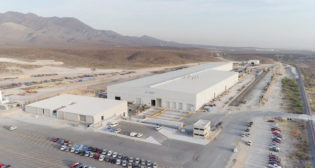
Jason Seidl: G&W positioning itself well for 2016
Written by Carolina Worrell, Senior EditorDespite a strong U.S. dollar, lower commodity prices and fewer coal shipments, Genesee & Wyoming Inc. on Feb. 10, 2016 reported a 2015 fourth-quarter revenue of $514.9 million, an increase of nearly 24% from the year-ago quarter, exceeding expectations of $510.5 million and $518.5 million, respectively. According to Cowen and Company Managing Director and Railway Age Wall Street Contributing Editor Jason Seidl, G&W “is positioning itself well” for 2016.
G&W’s fourth-quarter 2015 operating income was $94.6 million, down 16.6% from the comparable quarter in 2014. Adjusted diluted earnings per common share (EPS) of $0.85 decreased by 24.1% or 20.6%, excluding a $0.05 negative impact of foreign currency from the year-ago quarter, the railroad reported. Reported diluted EPS decreased 3.9% to $1.47, including a $0.47 impact from the Short Line Tax Credit and a $0.17 impact from a reduction in U.K. tax rates.
G&W’s adjusted operating income came in at $94.2 million, a decrease of 16.9% from fourth-quarter 2014—below Cowen and Company’s estimated $98.3 million but in line with the firm’s consensus, Seidl noted. Reported operating income decreased 16.6% to 94.6 million.
Same-railroad operating revenues, excluding a $16.6 million negative impact of foreign currency depreciation, declined 13.8%, primarily due to weakness in iron ore, coal, metals and agricultural products shipments, G&W reported. North American same-railroad revenue, excluding the $39.7 million negative impact of foreign currency depreciation, declined 11.4%, primarily due to weakness in metals and coal shipment. Australian same-railroad revenue, excluding foreign currency impacts, fell 28.8%, primarily due to lower iron ore shipments. The company said it is continuing to reduce costs in Australia.
Jack Hellmann, President and CEO of G&W, commented, “Our financial results for the fourth quarter of 2015 were consistent with our updated guidance, with adjusted diluted EPS of $0.85 down 24% versus last year, or down 21% excluding the impact of foreign currency. Each of our three operating segments, North America, Australia and the U.K./Europe, continued to face weak shipments in most commodity groups with same railroad carloads down approximately 16%. The weakness in our rail shipments has been largely driven by three overarching trends: i) the collapse in the prices of global commodities such as iron ore, copper, manganese and crude oil, ii) the rapid shift of U.S. and U.K. power generation away from coal to cheaper natural gas, and iii) a strong U.S. dollar, which has been making our industrial customers, such as steel manufacturers, as well as our agricultural customers less competitive in global markets. The trends that made 2015 difficult show few signs of abating in 2016. In North America, we anticipate our operating income to be down slightly as sustained weakness in coal and steel shipments is expected to offset positive trends such as core pricing. In Australia, we expect a decline in operating income due to the recent closure of a manganese mine and continued pressure on our remaining iron ore business. In the U.K./Europe, we expect operating income to be flat, but to improve in the second half of 2016 after we complete the restructuring of the U.K. coal business. The net impact of these trends and weaker foreign currencies is that we expect our adjusted diluted EPS to be down approximately 10% in 2016.”
“In response to this environment, we have been intensely focused on enhancing our free cash flow and positioning the business for improving trends in the future,“ Hellman said. “With respect to costs, we have made expense reductions in every operating region, with Australia now initiating a second round of cost cuts and the U.K./Europe planning significant cost reductions and a restructuring of our U.K. coal business in the first half of 2016. With respect to revenues, we continue to concentrate on commercial development worldwide, and have achieved strong revenues per carload in North America led by effective yield management. With respect to capital expenditures, we have been reducing our investment in plant and equipment to be consistent with our lower traffic levels. As a result of these measures, we expect to increase our free cash flow by approximately 10% to around $285 million in 2016, prior to capital for new business investments. Regarding acquisitions and investments, we continue to evaluate multiple opportunities worldwide and will weigh the relative value of these potential investments versus the intrinsic value of our own shares.”
“Several headwinds, including a collapse in global commodity prices, coal to gas switching in the U.S. and U.K. as well as a strong U.S. dollar had an adverse impact on the company,” Seidl said. “However, the company is taking necessary cost actions and will generate strong cash flow to continue growing through acquisitions. 2016 guidance was weaker than we expected largely due to macro concerns, but G&W possesses a management team with a proven, long-term track record of delivering for shareholders.”
Seidl noted that G&W “is positioning itself well” by reducing its capex nearly 30% in 2016 to $225 million, which is essentially all for maintenance purposes. As a result, free cash flow should increase by about 10% year-to-year to $285 million. “We think there may be opportunities for G&W to spend that cash on short line acquisitions that the Class I’s are looking to spin off in 2016, which is likely one reason why the company has not stepped up its share repurchase efforts,“ he said. ”Core pricing is expected to moderate to 3% in 2016, down from a pace of 3.5% in 4Q15, which is consistent with the results from our recently published Rail Shipper Survey.”
“While coal actually provided $1 million of incremental support to revenue in 4Q15 vs. 3Q15, management alluded to a significant public policy issue on the horizon in the U.K., given the country’s limited coal resources,” Seidl said. ”In North America (80% of EBIT), cost reductions are focused on removing locomotives from service, headcount reductions and G&A cuts. In Australia (11% of EBIT), G&W is reducing costs related to the November manganese mine closure. In Europe/U.K. (9% of EBIT), the coal business is being restructured, as $5 million in EBITDA has been lost due to gas switching. There are three parts to the U.K. coal business restructuring, including the transition of leased locomotives to other services, reducing the workforce and letting coal car leases expire. The company had expected for that business to fade by 2022. Also, some of Freightliner’s marginal continental European intermodal business is being eliminated.”
“We are lowering our 2016 EPS estimate to $3.70 from $4.45 to reflect continued weakness in freight markets this year. Our price target drops to $69 from $76 based on our new 2017 EPS estimate of $4.30 and a 16x multiple,” Seidl said.
Additionally, G&W reported on Feb. 10, 2016 January 2016 traffic volumes of 218,431 carloads, an increase of 51,082 carloads, or 30.5%, compared with January 2015. G&W’s same-railroad traffic in January 2016 was 139,511 carloads, a decrease of 27,838 carloads, or 16.6%, compared with January 2015.
Traffic for G&W’s North American Operations in January 2016 was 124,416 carloads, a decrease of 16.6% compared with January 2015. The decrease was primarily due to reduced shipments of coal & coke, minerals & stone, metals and agricultural products.
Traffic in January 2016 for G&W’s Australian Operations was 15,095 carloads, a decrease of 16.8% compared with January 2015. The decrease was primarily due to reduced metallic ores shipments from the closures of customer iron ore and manganese mines in 2015.
Traffic for G&W’s U.K./European Operations was 78,920 carloads in January 2016. Traffic in January 2016 was led by intermodal traffic in the U.K. and continental Europe as well as minerals & stone traffic in Poland and the U.K.



